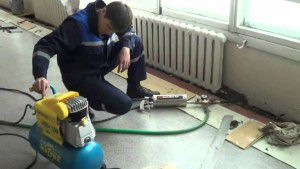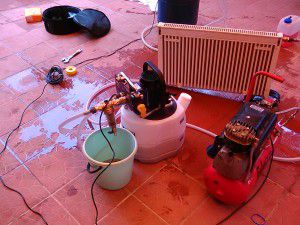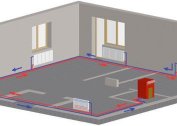During operation of the water heating system, limescale forms on the inner surface of the walls of the pipes and radiators, and a layer of rust forms. Over time, this will interfere with the normal operation of the heat supply. Therefore, it is necessary to periodically flush the heating system of a private house and apartment, acts and samples of which are an integral part of the procedure.
Relevance of heating flushing
First of all, it is necessary to determine that the time has come to clean the heat supply from deposits. High-quality flushing of boilers and heating systems is necessary if malfunctions are clearly observed, the heat transfer of radiators and batteries is significantly reduced.
During operation of heating, plaque is formed on pipes and radiators, which includes rust (25%), lime deposits (60%) and components from copper and zinc oxides (15%). To remove them, timely flushing of the heating system in a private house is necessary. According to current regulations, the frequency of this procedure is determined. It depends on the material of the manufacture of heat supply and the period of its operation. On average, the frequency of flushing the heating system with a hydraulic method is 1 time per year. Chemical cleaning is performed less frequently - once every 5-7 years.
There are certain signs in the operation of heating, which indicate the need for flushing:
- Decrease in the estimated volume of the heat carrier. This is due to a decrease in the cross section of the pipes due to the formed plaque;
- Heat dissipation has become lower. If the heating radiators in the apartment have not been flushed for a long time, lime deposits will reduce the heat transfer rate of the battery;
- Frequent clogging of filters, breakdown of the circulation pump. When a certain thickness is reached, the scale begins to break. Its particles in the coolant will clog the filters, and can cause a pump failure.
If at least one of the above signs is present, it is necessary to flush the heating system with your own hands or using the services of specialized companies. But even if deviations in the work of heat supply are not observed, this procedure should still be carried out. The recommended frequency of flushing the heating system was mentioned above.
If you want to independently clean the heat supply, you will need a unit for flushing the heating systems. It is best to rent it, as the purchase price will be high.
Hydraulic flushing of heating
One of the simplest and most effective ways to clean the inside of pipes and radiators is to hydraulically affect limescale. To do this, you need a compressor to flush the heating system with a filtration system.
The essence of this method is to create, using special equipment, a large head of water that destroys plaque on pipes and radiators. No special flushing fluid is used for this. A feature of the technology is the use of hoses with nozzles. They have small nozzles, which create the required pressure of water.
In this way, you cannot immediately descale the entire system. First, the heat supply areas are determined on which to do the washing of the heating system with your own hands.Then the inlet and outlet nozzles from the pump are connected, forming a closed loop. The degree of cleaning is controlled by the clogging of the filter, which must be included with the compressor for flushing the heating system. Also, when choosing this cleaning method, you need to consider the following nuances:
- Pressure value. It should be at least 0.6 MPa. Otherwise, the coating will not be destroyed, which will affect the efficiency of the procedure;
- Pipe Material. During the washing process of boilers and heating systems, other components of the heat supply must not be affected. This can occur if the maximum pressure is exceeded for plastic and polypropylene lines;
- Air Removal. Before washing the heating radiators in the apartment, you need to open the Majewski tap and wait for the air to exit the system. Only then can cleaning be carried out.
Despite the effectiveness of this method, it is not often used. This is due to the complexity and strict rules of the procedure. Therefore, special solutions are most often used to flush the heating system.
In order to avoid creating emergency situations before connecting the compressor to flush the heat supply system, it is necessary to carry out calculations of the main indicators - maximum pressure, pressure head, etc.
Chemical flushing of the heating system
Almost all types of deposits on pipes and radiators can be dissolved using special chemicals. Chemical flushing of the heating system is less time-consuming than hydraulic and does not require sophisticated equipment.
The principle of this method is to destroy the sediment layer. Losing its uniformity, it is divided into many small particles, which are then removed from the heat supply system.
For this, it is necessary to use a special liquid to flush the heating, which will not destructively affect the pipes and radiators. Therefore, before performing the cleaning, it is necessary to choose the correct chemical solution.
There are two ways to flush a heating system:
- With connection to the system. It is similar to hydraulic, with the exception of the working environment. Instead of a descaling hose, a radiator flushing agent is used. In this way, radiators and heat supply pipes are cleaned;
- Dismantling heating elements. In this case, you will not need to rent or purchase a unit for flushing heating systems. It is important to choose the right fluid. After dismantling the gas boiler’s complex heat exchanger, it is placed in a container into which a solution is poured to flush the heating system. After a certain period of time, the heat exchanger is washed with water and again installed in the boiler.
In most cases, special chemicals are used to flush the heating. Its composition was not disclosed by the manufacturer. But it is known that stonecrop is most effective when using inorganic acids in various proportions - hydrochloric, sulfuric and phosphoric. To improve the result, special additives and inhibitors are added to the chemistry for washing the heating. They form an additional layer on the inner surface of steel pipes and radiators, protecting them from oxidation. At the end of the procedure, an act of flushing the heating system is mandatory, where these funds are indicated.
To neutralize the chemical effect on pipes and radiators, in some cases, soda ash or baking soda is added to the water before washing the boilers and heating systems. But this should be determined only by a specialist.
Rules for flushing heating in an apartment building
Compliance with the frequency of flushing the heat supply system in an apartment building is an important stage in the maintenance of heating. However, not every tenant knows who should be responsible for this procedure and the procedure for its implementation.
It should be noted that the entire heating system in an apartment building is divided by property rights. Everything located in the apartment should be serviced by its owner. The Management Company is obliged to maintain the working condition of all other highways and elements by using special installations for flushing heat supply systems. In case of non-compliance with the service rules, she is fully responsible for the occurrence of emergency situations or malfunctions in heating.
To clean the heat supply, it is best to use chemicals for washing heating radiators and pipes. This can be done independently or through the services of specialized companies. They will be able to choose the right solutions for washing the heating and carry out this procedure in accordance with established standards. After cleaning, a document must be requested. A sample act of flushing the heating system can be taken in advance to familiarize yourself with it.
For the owner of the apartment, he is essentially not needed. This document may be required if the Management Company tries to accuse a tenant of improper flushing of radiators and heating pipes in the apartment in the event of a heat supply accident. The presence of an act will indicate compliance with performance standards. In other cases, filling out the flushing act of the heating system is done only when ordering the cleaning of a common heating supply.
The following points should be filled out in the sample act of flushing the heating system:
- The selected cleaning method is chemical or hydraulic;
- Applied means for washing pipes and radiators - pumps, compressors, chemical components;
- The effect of cleaning is an increase in heat transfer, improving the quality of the system, saving heat energy;
- Responsible organization and its representatives performing hydraulic or chemical flushing of the heating system.
All these nuances should be displayed in the document. Residents of the house have the right to demand from the Management Company an act of flushing the heat supply system to make sure that it performs the functions assigned to it.
The cleaning procedure for the heat supply system is performed before the start of the heating season, but until the pipes are filled with coolant. This must be taken into account when independently flushing the heating system in the apartment.
Procedure for flushing in autonomous heating
The autonomous heating system of a private house is most susceptible to the appearance of limescale on pipes and radiators. Timely cleaning of the system will allow you to maintain its original parameters and prevent the occurrence of emergency situations.
This procedure can be performed using chemicals or using the hydraulic cleaning method. If obvious and indirect signs indicate the need to flush the heating system in a private house - it is best to plan events outside the heating season. According to the technology, after cleaning the heating, it is crimped and filled with coolant. Therefore, flushing is done before starting the heat supply.
There are two ways to remove blockages from pipes and radiators - with their dismantling and non-separable. The first is used with a significant concentration of scale. The second method is easier and takes much less time.
Stages of flushing the heat supply system in a private house without dismantling:
- Coolant drain from the system. Its reuse is prohibited due to heavy pollution.
- Flushing equipment connection - pump or compressor.
- Filling the tank with liquid. When using chemical cleaning, you must first familiarize yourself with the instructions from the manufacturer. Be sure to take into account restrictions on use.
- Turn on equipment and performing several washing cycles.
- Filter Status Monitoring. If necessary, the cleaning fluid is replaced with a new one.
- For chemical cleaning - mandatory flushing of the system with distilled water, if such a procedure is indicated by the manufacturer of the composition.
The correct implementation of these steps ensures the normal operation of the system and the absence of blockages in the pipes and radiators.
Chemical cleaning using inorganic acid based compounds is prohibited for polymer pipes and aluminum radiators. In this case, it is recommended to use the hydraulic flushing method.
Prevention of blockages in heating
Often, the reasons for the formation of a large amount of scale are the failure to comply with basic heating protection means. There are a number of factors that directly affect these processes. Knowing the causes of their occurrence and preventive measures can reduce the likelihood of blockage of heat supply.
The main factor in the appearance of limescale in pipes and radiators is the poor-quality composition of the coolant. This is due to the large amount of salts and metals in the water. Therefore, experts recommend using only distilled water as a coolant. But even foreign elements will appear in it from time to time - rust particles, polymer breakdown products. Therefore, before each heating season, it is necessary to change the coolant to a new one.
Another cause of plaque is the high oxygen content in the water. This is especially true for open heating systems. Its presence increases the corrosion of metal elements, which subsequently form the bulk of the pollution. To remove air from the heat supply of a private house, you must install a special filter.
Washing the heating system is a critical step in its maintenance. The performance of all components depends on the quality of this procedure. Therefore, before choosing a specific cleaning method, you should analyze whether it is suitable for a specific heat supply or not. In case of difficulty, it is recommended to consult with specialists.
The video shows an example of flushing the heating system in a public building:









